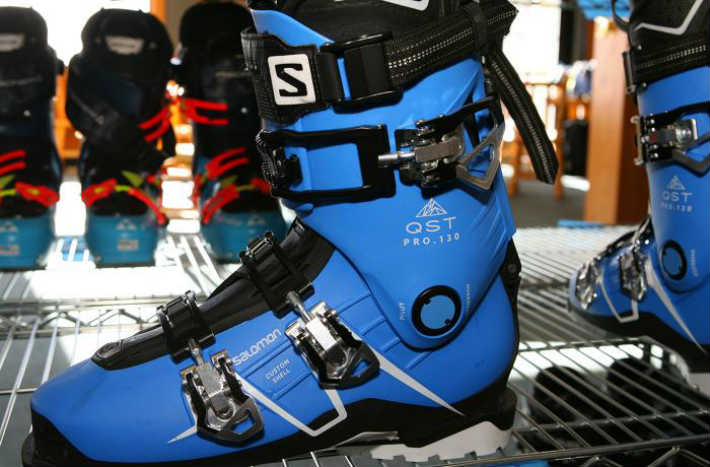Whether you’re looking to push yourself to the next level, or you want to spend more time adventuring on the slopes, your choice of ski boots can make or break your enjoyment on the mountain. While most first-timers rent their shoes from a rental store in the resort they’re staying in, let’s face it – owning your own pair, even if you’re skiing only semi-frequently is much better than renting boots that many other people’s feet have sweated in. And while rental stores probably wash and apply some antibacterial spray on them, they’re still not as hygienic as you’d like them to be. Plus, owning your own pair is the more valuable investment in the long run. But where do you even start when it comes to looking for the right pair of ski boots?

First and foremost, you need to learn the lingo and find out which brands are the leading ski boots manufacturers. ‘Last’, ‘flex’ and ‘mondo’ are the three keywords you need to pay attention to when shopping for boots, and some of the best brands today are SALOMON, ROJO, XTM, Tecnica, DALBELLO, just to name a few. While buying shoes from any of these brands is going to be more expensive, you’re guaranteed quality and reliable customer support not only when buying, but after the fact as well. That being said, no matter whether you decide to buy your new pair of ski boots from SALOMON, ROJO, XTM or any of the other industry-leading brands, there are a couple of important things to bear in mind.
Mondopoint (Mondo)
Mondopoint is the scale on which ski boots are measured on. This scale is based on the length of your feet in centimetres. You can determine the ideal Mandopoint size by putting your heel against a vertical surface and pointing your toes outwards, and measuring the distance from the wall to the end of your longest toe. If the length of your foot measures at 25cm, your indicated Mondopoint size is 25cm. You can also use a conversion chart online, but it’s less than ideal and should be avoided because shoe sizes are inconsistent and people often wear everyday shoes that don’t fit them properly. While most people can get away with walking in shoes that are a size too big, skiing is much more demanding and needs a proper fit.

Beginner skiers should pick a boot that’s close to the indicated Mondopoint length, even if it feels slightly smaller. This is due to the fact that the liner of the boot will compress after a couple of uses, so you’ll generate more space. Advanced skiers should also pick a boot close to their indicated size, or even a slightly shorter one but in a stiffer flex. Expert skiers should pick a boot that’s a full size smaller than the indicated size for the most responsive and precise fit, with a very stiff or stiff flex.
Last
Besides the Mandopoint of the shoes, you need to consider the last or the width. The last of ski boots is based on the width of the forefoot, which is measured on a slight diagonal across the metatarsal heads. Most brands feature two or three types of lasts to fit different types of feet. These lasts are divided into wide, medium and narrow. Lasts with a wide forefoot typically feature increased interior volume everywhere else in the boot as well. Wide lasted boots are suitable for skiers with wide and high volume feet, and they generally feature a forefoot width of 102 to 106mm. Average lasted boots feature a forefront width of around 100mm (give or take), and they have a more relaxed fit through the heel and midfoot. Narrow lasted boots typically feature a forefoot width of around 97 to 98mm, and they’re narrow through the midfoot.

Flex
The flex of the ski boots refers to the difficulty at which the boot flexes forward. Boot flex can range from race stiffness to very soft, indicated by a flex index that’s generally a number between 50 (for soft flex) to 130 (for stiff flex). Oftentimes, this number is found on the outside of the boot’s cuff. There’s no standardised way to measure flex, so a boot with 100 flex from one company may not be equal to a boot with 100 flex from another company. In fact, some companies use a 1-10 scale, which is why flex types are also characterised as soft, medium, stiff and very stiff.
The type of snow you’re skiing over, terrain and speed will all play a role in choosing the ideal flex. Professional big mountain and freeride skiers generally opt for softer boots than pro racers. This is due to the fact that steep terrain with variable snow oftentimes demands more cuff movement, whereas uniformly smooth surfaces demand more tip pressure. Physical makeup and personal preference are also to be considered. Most beginners would do fine with a stiff or medium boot, whereas more seasoned skiers would prefer a very stiff one for more responsiveness. Just go online and check out ROJO, XTM or SALOMON snow gear to find everything you need for your next adventure at a price you can afford.



